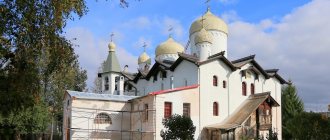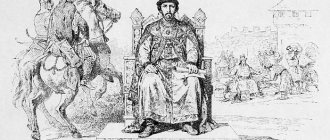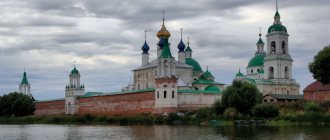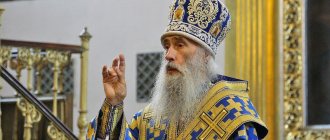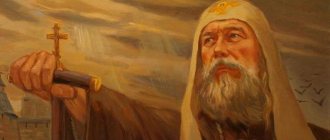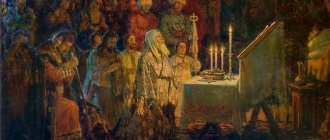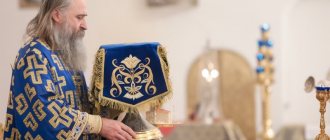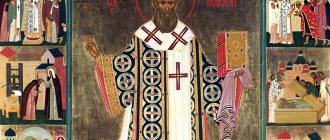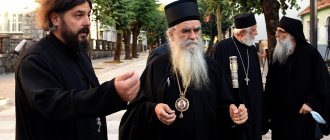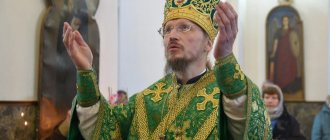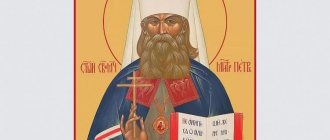February 11, 1507 – December 23, 1569 (62 years old)
4.2
Average rating: 4.2
Total ratings received: 19.
Philip II, in the world Fyodor Kolychev (1507–1569) - bishop of the Russian Church, Metropolitan of Moscow and All Rus' in the period from 1566 to 1568. He went down in history as the main exposer of crimes committed by the guardsmen of Tsar Ivan the Terrible. Philip Kolychev, whose biography is inextricably linked with one of the dark pages of Russian history, managed to accomplish many good deeds, earning respect among the people. We invite you to read a report for children on the topic of what Metropolitan Philip II did and what actions he became famous for.
early years
Fyodor Stepanovich Kolychev (the metropolitan's secular name) was born on February 11, 1507. The boy's parents belonged to an old boyar family. Little Fedya was prepared by his father for the sovereign service, while his mother instilled Christian values and raised him in piety and reverence for Orthodoxy.
As a child, Fyodor was taught to read and write from church books, taught to sit confidently in the saddle and wield a weapon. Despite the fact that the boy perfectly mastered military skills, he gravitated more toward books and prayers.
When Fedor grew up, he was employed at the court of Vasily III. However, during court intrigues, the Kolychev family fell into disgrace. Many of Fedor's relatives were executed, and the young man was forced to leave the capital.
Slandered and killed
The Tsar did not expect such a strong and public confrontation from Metropolitan Philip. The public condemnation of innocent murders and the call for mercy aroused rage. The Tsar gives the order to seize the Metropolitan and bring the head of the Russian Church to trial for his “vicious life.”
The bishop's robes were torn off Metropolitan Philip right in the church, during the service, and replaced with a torn cassock.
Some hierarchs resisted the trial, and when, under pressure from the tsar, the first hierarch of the Russian Church, Metropolitan Philip, on the basis of slanderous testimony, was nevertheless found guilty of a “vicious life,” they did not allow him to be burned, as was required according to the canons for such a crime. The death penalty was replaced by exile to the Tver Otroch Monastery.
N.V. Nevrev, “Metropolitan Philip and Malyuta Skuratov” (1898). Image from rodon.org
But the revenge of Ivan the Terrible, who failed to achieve a public execution for Philip, did not slow down. Oprichnik Malyuta Skuratov-Belsky, the personal killer of Ivan the Terrible, secretly came to the monastery and killed the saint.
In 1590, the relics of St. Philip were transferred from the Tver Otroch Monastery to Solovetsky, and in 1652, by order of Patriarch Nikon and with great celebrations, to the Assumption Cathedral of the Moscow Kremlin. There they still arrive in a shrine at the southern entrance to the temple, in front of the iconostasis.
Solovetsky Monastery
Fyodor managed to get to the Solovetsky Monastery, where he was accepted as a novice. Along with other novices, yesterday’s darling of fate worked a lot and hard: he carried stones, chopped wood, dug the earth.
A year and a half later, Fyodor took monastic vows and received the name Philip. In 1548, the Solovetsky abbot, due to his venerable age, resigned and proposed to appoint Philip as his successor. The monastery council supported this decision, and Philip was unanimously elected abbot of the Solovetsky Monastery.
Philip proved himself to be a competent administrator, under whom the Solovetsky Monastery in a short time became the cultural and industrial center of Northern Pomerania.
short biography
- In 1537, the Kolychevs fell into disgrace for supporting Prince Andrei , who opposed Elena Glinskaya, the mother of Ivan IV. The Staritsky prince started a riot in Novgorod, for which he was thrown into prison. Some of Fyodor’s relatives suffered along with him: his uncle went to prison, and his two second cousins were whipped and executed. After the incident, the boyar himself changed into the clothes of a commoner and, without saying goodbye to his parents, secretly left Moscow. According to the life, Fyodor’s act was not associated with persecution; service at court had long been a burden for Kolychev; he was more attracted to monastic life. During one of the services, the young man was struck by the words of the Gospel, and he finally decided to leave the world.
- Having left Moscow, he headed north to the Novgorod lands . Tired of the long journey, the man stopped at Lake Onega near the village of Kizha . A local peasant named Sidor Saturday sheltered the wanderer and entrusted him with herding sheep. After some time, Fedor continued his journey, reached the Solovetsky Islands and entered the famous Spaso-Preobrazhensky Monastery . The boyar had to get used to hard work, for a year and a half he fulfilled all the obediences that Abbot Alexy gave him: he carried stones, chopped wood, collected bread, dug the earth.
- In 1539 he was tonsured a monk with the name Philip . Elder Jonah Shamin, a spiritual child and disciple of Saint Alexander of Svir, began to mentor the monk.
- In 1548, the aged abbot of the monastery resigned . Alexy proposed to put Philip in his place. The monastery council elected a successor as abbot, then Novgorod Archbishop Theodosius elevated him to the rank.
- In subsequent years, the new rector showed himself to be a caring and competent business executive . Under him, canals between the lakes were dug on the island, mills and various outbuildings appeared. Philip also introduced mechanical improvements, which made it easier for the brethren to work in the monastic industries. The monastery grew and flourished, the monks built two cathedrals, multi-story cells and a hospital. The beaters and rivets were replaced with bells.
- In the late 40s and early 50s. he renewed the wooden chapels over the graves of the founders of the monastery, Saints Zosima and Savvaty , and also transferred the relics of the saints to the Transfiguration Cathedral and ordered large hagiographic icons for each of them. The abbot worked hard for the memory of the founding fathers, looking for relics associated with their earthly life and spiritual deeds.
- During the period of his abbess, Philip was engaged not only in the economic affairs of the monastery, but also in spiritual work . He often went to pray in the desert, which later received his name. According to church tradition, the Lord Jesus Christ once appeared to the saint wearing a crown of thorns. In the place where the miracle happened, a clear spring came out of the ground. The abbot built a chapel over the holy spring.
- In 1551 he took part in the Council of the Stoglavy , where he met with the matured Tsar Ivan IV .
- In 1555 he quarreled with the Solovetsky elder Zosima . The Church Council examined the case and decided to recognize the abbot as innocent, return him to the monastery, and relocate the elder to another Orthodox monastery.
- In 1566, at the call of the tsar, he arrived in Moscow and, by decision of the council of bishops, was elected Metropolitan of Moscow and All Russia . Before his ordination as bishop, Philip told the king that he would agree with the appointment only if the ruler destroys the oprichnina, which commits lawlessness and brings many troubles to the people. Ivan refused and silenced the abbot. Nevertheless, the members of the council were able to persuade Philip to yield. On July 25, the Solovetsky monk was consecrated bishop, after which he was proclaimed Metropolitan of Moscow and All Rus'.
- Over the next year and a half, the Metropolitan took care of church affairs and also interceded with the Tsar on behalf of the disgraced, thanks to which there were fewer executions in Moscow.
- In 1567, due to the death of several hierarchs, he convened a church council to install new bishops in the vacant sees. Ivan the Terrible was also present at the cathedral .
- In the winter of 1568, the tsar’s subordinates intercepted several letters from the Poles to the Moscow boyars calling on them to go over to the enemy side. Ivan the Terrible began executing boyars and their families en masse. Philip repeatedly appealed to the ruler's conscience, trying to stop the oprichnina, but all his efforts were in vain.
- In March, the Tsar came to the Assumption Cathedral of the Kremlin for a service performed by the Metropolitan. After the liturgy, the bishop refused to bless Ivan and denounced him for the robberies and murders committed in the royal name. The king was angry, but did not dare to directly harm Philip, since the people revered him. The guardsmen began to torture the boyars close to the metropolitan, wanting to find evidence against the hierarch. Having learned about this, the bishop moved from his residence to one of the monasteries.
- On July 28, the Metropolitan again angered the Tsar by making a remark to his guardsman during the religious procession. Ivan flew into a rage, called the accuser and began to prepare a church trial against him.
- Archbishop Pimen acted as the main prosecutor . Even before the verdict, Philip renounced the metropolitan throne, saying that he would rather accept death than rule under lawlessness. On November 4, the council, under pressure from the tsar, deprived Philip of his dignity and a few days later sent him to prison in the monastery of St. Nicholas the Old . Before this, the hierarch was kicked out of the cathedral in disgrace in front of the parishioners. After a while, the cruel ruler sent the saint the head of his executed nephew.
- In 1569, the disgraced bishop was exiled to Tver to the Otroch Assumption Monastery. At this time, several relatives of Kolychev were executed. On December 23, the Tsar's right hand, Malyuta Skuratov , entered the dungeon and killed Philip. According to the life compiled by Saint Demetrius of Rostov, Malyuta asked the king to give his blessing for the campaign and, after the saint’s refusal, strangled him. Later, many historians came to the conclusion that the murder was committed on the orders of Ivan the Terrible himself.
- In the 1590s. An unknown monk of the Solovetsky monastery wrote the life of the murdered bishop.
- In 1652, Tsar Alexei Mikhailovich, at the suggestion of Patriarch Nikon, ordered the relics of the murdered bishop to be transferred to Moscow. Philip was canonized for all-Russian veneration as a saint. The saint's commemoration days were also established: January 9 , July 3 and October 5 .
- In the 20th and 21st centuries. The image of the metropolitan has been used more than once in cinema, in particular in films about Ivan the Terrible. Over the years, the saint was played by such actors as Andrei Abrikosov, Galiks Kolchitsky, Vaclav Dvorzhetsky and Valery Nikitin. In 2009, director Pavel Lungin shot the feature film “Tsar ,” entirely dedicated to the relationship between the Metropolitan and Ivan IV. The role of the Moscow saint was played by the famous actor Oleg Yankovsky, who was already seriously ill at the time of filming. This work was the last in the artist’s life; he died three days after the film was shown at the Cannes Film Festival.
Philip II in captivity
Moscow Metropolitan
By the time the Moscow Metropolitan was elected, a difficult situation had developed. The main contender for the position, Archbishop Herman, openly criticized the policies of Ivan the Terrible, as a result of which he fell into disgrace. As a result, in 1566, the tsar summoned Philip to Moscow and offered to ordain him. Philip wanted to agree to this proposal only after the destruction of the oprichnina, but those close to him managed to persuade Philip not to cross the cruel ruler and accept a high rank.
Thus, not only the large Moscow diocese, but also the entire Russian Church became subordinate to Philip. Endowed with great power, he sought to soften the harsh policies of Ivan the Terrible and develop book printing.
Escape from home
The future Saint Philip fled from Moscow in his youth.
Himself from the noble Kolychev family, he did not want to participate in boyar squabbles under the teenage Tsar, the future Ivan the Terrible. And he had no inclination towards court life, he loved to sit with a book, not only divine, but also from the science of fortification, and engineering, and history, and agriculture. All this would come in handy later, on Solovki, where he would build the most modern irrigation system for its time, and melons would be grown in greenhouses.
Fyodor Kolychev fled from a rich house without money and secretly, and along the way he hired himself to graze a peasant flock, receiving his bread. He wanted to become a monk. Having reached Solovki, Fyodor Kolychev took monastic vows with the name Philip.
Fyodor Kolychev leaves his parents' home; stamp of a hagiographic icon
Persecution
In a short biography of Philip Kolychev, it is important to mention his difficult relationship with Tsar Ivan IV. Mass executions, terror against the tsar's subjects and ordinary people, and the oprichnina haunted the metropolitan, who considered such government of the state unacceptable. When Ivan the Terrible asked Philip for a blessing at a service, he pretended not to notice the king.
The consequences of such an act were serious. Many of the Metropolitan’s entourage were executed and tortured, and the collection of “incriminating” evidence against Philip began.
In 1568, during a service in the Kremlin church, the news about the deprivation of the metropolitan's dignity was announced. Soon a church trial took place over Philip, after which he was placed as a prisoner in the Epiphany Monastery.
Documents have been preserved according to which Ivan the Terrible intended to publicly burn Philip Kolychev, accusing him of witchcraft. Only thanks to the intervention of the clergy the former metropolitan’s life was saved. The final sentence for him was lifelong imprisonment in a monastery.
Denial of blessing
In 1567, while investigating the case of the groom I.P. Fedorov, one of the top officials in the state, the tsar used mass executions. Many innocent people were subjected to repression - nobles, their servants, family members, peasants. Muscovite Rus' did not know such blood; it was not part of its political traditions.
Metropolitan Philip persuaded the Tsar to abandon the oprichnina: “... I began to ask the Tsar to retreat from such an objectionable undertaking. And he reminded him of the Gospel word: “If the kingdom is divided against itself, it will perish,” writes the Metropolitan.
Y.P. Turlygin, “Metropolitan Philip denounces Ivan the Terrible” (1800). Image from aminpro.ru
Having not achieved his goal, the Metropolitan denounces the guardsmen in public: “We offer a pure and bloodless sacrifice to the Lord for the salvation of people, but behind the altar innocent Christian blood flows and people die in vain!”
He publicly in the temple refuses the Tsar’s blessing, calling on Ivan Vasilyevich to first forgive those who “sin” him.
Death
In 1569, the beloved guardsman of Ivan the Terrible, the nobleman Malyuta Skuratov, came to the imprisoned elder’s cell to fulfill the royal commission and ask Philip for his blessing for the upcoming military campaign.
The clergyman refused to bless the king, and Skuratov strangled him. He announced that the old man had died of intoxication in a hot cell. Historians have no doubt that the murder of the Metropolitan was a secret order of Ivan the Terrible.
In 1591, at the urgent request of the brethren of the Solovetsky Monastery, the relics of Philip were buried in the Transfiguration Cathedral on Solovki. At the end of the 16th century, the first life of Philip was compiled, and the date of January 9 became the day of veneration as a saint.
Where is Metropolitan Philip buried?
Figure 2. Relics of Metropolitan Philip II
Immediately after his death, the remains of Metropolitan Philip were urgently buried in the monastery graveyard. However, already in 1591 the relics were seized and moved under the porch of the chapel of Saints Zosima and Savvaty of the Transfiguration Cathedral.
Half a century later, on the initiative of Tsar Alexei Mikhailovich, Metropolitan Nikon of Novgorod and Patriarch Joseph, the remains were transported to Moscow, where they remain today. They were placed in a silver reliquary of the Assumption Cathedral next to the iconostasis, and covered with a board made of silver, captured by Kutuzov from Napoleon’s troops.
Confrontation between Philip and Ivan the Terrible
Returning in the winter of 1568 from the first Livonian campaign, the king began a new wave of terror. The reason was intercepted letters to the Moscow boyars of the Polish king Sigismund and Hetman Khodkiewicz with a proposal to move to Lithuania. Mass executions began. Boyar Ivan Chelyadin died, then princes I.A. Kurakin-Bulgakov, D. Ryapolovsky, three princes of Rostov, princes Shchenyatev and Turuntai-Pronsky, who became monks.
At the same time, an open conflict began between the king and the spiritual authorities. Philip spoke out against oprichnina terror. At first he tried to stop the lawlessness in private conversations with the tsar, asking for the disgraced, but Ivan the Terrible began to avoid meetings with the metropolitan. Then, according to Andrei Kurbsky, Philip “began to pray first in time, as the great apostle said, and it is timeless; then he will be condemned by the terrible judgment of Christ, exhorting him according to the episcopal power given to him by God.”
Ivan groznyj. (Wikimedia Commons)
